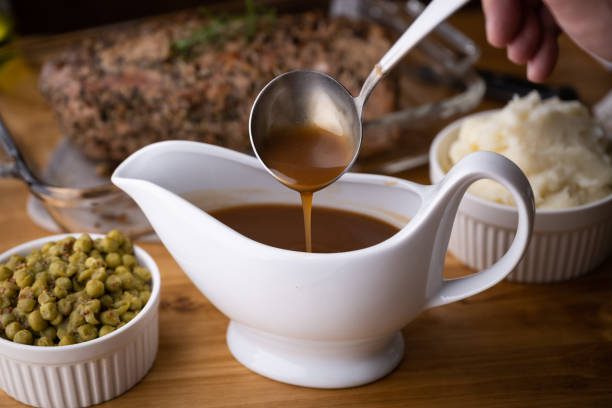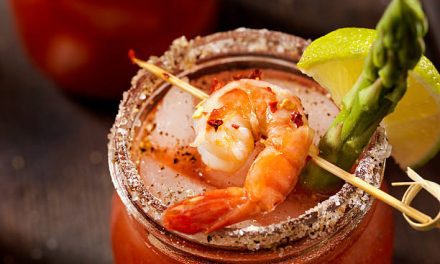Homemade Gravy Recipe and History
Homemade gravy is a timeless comfort food staple — rich, silky, and bursting with savory depth. Whether poured over roasted turkey, mashed potatoes, or biscuits, it ties every element of a meal together with warmth and flavor. While many reach for store-bought versions, nothing compares to the taste of freshly made gravy simmered from real pan drippings or flavorful stock. Beyond its irresistible taste, gravy has a fascinating history that spans centuries of culinary evolution across cultures.
The History of Gravy
Gravy’s story begins in medieval Europe, where cooks developed sauces from meat juices and wine to enhance roasted meats. The word “gravy” comes from the Old French gravé or grané, meaning “broth” or “sauce.” These early gravies were simple reductions made from the natural drippings of meat, combined with wine or stock, and thickened with breadcrumbs or flour.
By the 17th century, gravy had become a cornerstone of English and French cooking. It appeared in early cookbooks such as The Compleat Cook (1658), where recipes featured roast beef drippings seasoned with herbs and spices. When European settlers brought these techniques to America, gravy evolved alongside regional cuisines — from the creamy white gravies of the Southern United States to the rich brown gravies of New England.
During the 19th and 20th centuries, gravy became synonymous with home cooking and Sunday dinners. It represented comfort, thrift, and resourcefulness, as homemakers turned leftover drippings into flavorful sauces to stretch a meal further. Today, gravy remains one of the most beloved accompaniments for roasts, meats, and holiday feasts.
Ingredients
For Classic Brown Gravy:
- 2 tablespoons butter (or pan drippings from roasted meat)
- 2 tablespoons all-purpose flour
- 2 cups beef, chicken, or turkey stock (depending on the meal)
- Salt and pepper to taste
- Optional: 1 teaspoon Worcestershire sauce or a splash of soy sauce for richness
For Creamy White Gravy (Southern Style):
- 3 tablespoons butter, bacon fat, or sausage drippings
- 3 tablespoons all-purpose flour
- 2 cups whole milk
- Salt and freshly cracked black pepper to taste
Instructions
1. Prepare the Roux:
In a medium saucepan, melt the butter or drippings over medium heat. Once hot and bubbly, whisk in the flour to form a smooth paste called a roux. Continue whisking for 2–3 minutes, allowing it to cook until lightly golden (for white gravy) or deep brown (for brown gravy). This step removes the raw flour taste and builds flavor.
2. Add the Liquid:
Gradually pour in your stock (or milk for white gravy), whisking constantly to prevent lumps. The mixture will begin to thicken as it simmers. Continue whisking for 5–7 minutes until smooth and creamy.
3. Season and Serve:
Season with salt, pepper, and any optional flavor boosters such as Worcestershire sauce, garlic powder, or a dash of thyme. If the gravy is too thick, add a splash more liquid; if too thin, let it simmer a bit longer.
4. Strain (Optional):
For an ultra-smooth texture, strain the gravy through a fine-mesh sieve before serving.
This recipe yields about 2 cups of gravy — enough for 4 to 6 servings.
Variations
Turkey Gravy: Use the drippings from roasted turkey, skim off excess fat, and mix the remaining juices with stock and flour for the ultimate Thanksgiving companion.
Onion Gravy: Sauté sliced onions in butter until caramelized, then stir in flour and beef stock for a rich, savory sauce perfect with mashed potatoes or sausages.
Mushroom Gravy: Add finely chopped mushrooms to the roux and cook until tender before adding vegetable or beef stock — ideal for vegetarian meals.
Herbed Gravy: Stir in chopped rosemary, sage, or thyme for an aromatic twist that pairs beautifully with roasted poultry.
Creamy Country Gravy: Made with sausage drippings and milk, this version is a Southern breakfast classic served over biscuits or fried chicken.
Cultural Significance
Gravy is much more than a sauce — it’s a culinary tradition that brings families together. In many cultures, it symbolizes resourcefulness, using every part of the meal to create something rich and satisfying. In the American South, for example, white gravy is deeply rooted in farm life, where nothing went to waste. A handful of flour and a little milk could turn bacon grease into a flavorful breakfast staple.
Across the Atlantic, the British and French elevated gravy into a fine art of sauce-making. French chefs refined techniques for jus and velouté, while the British made gravy the centerpiece of Sunday roasts — a tradition that continues today. In America, gravy’s versatility allowed it to adapt to every regional palate, becoming brown and robust in the North, and creamy and peppery in the South.
Nutritional Value
While traditional gravy is indulgent, it can be made healthier without losing its appeal. Using low-sodium stock, reducing butter, and thickening with cornstarch instead of flour lowers fat and sodium content. Mushroom or vegetable gravy offers a nutrient-rich vegetarian alternative with plenty of umami.
Gravy also plays an important role in satiety. Its combination of fat, protein, and starch adds comfort and satisfaction to meals, helping stretch smaller portions of meat or vegetables into hearty servings.
Tips for Perfect Gravy
- Avoid Lumps: Always whisk continuously when adding liquid to the roux. Warm stock blends more smoothly than cold.
- Balance Flavor: If the gravy tastes flat, a dash of soy sauce or vinegar can enhance depth and brightness.
- Use Pan Drippings: These provide the best flavor foundation — the browned bits left after roasting are liquid gold.
- Adjust Consistency: Remember that gravy thickens as it cools; remove it from heat when it’s slightly thinner than desired.
- Make Ahead: Gravy can be refrigerated for up to 3 days or frozen for 2 months. Reheat slowly, adding stock or milk as needed.
Serving Suggestions
Homemade gravy pairs beautifully with a variety of dishes — roast turkey, chicken, beef, or pork. It’s the crowning glory on mashed potatoes, stuffing, and Yorkshire pudding. White gravy complements Southern comfort foods such as biscuits, fried chicken, or country-fried steak. For a festive touch, drizzle it over roasted vegetables, shepherd’s pie, or meatloaf.
The Legacy of Gravy
Few sauces have achieved the universal appeal of gravy. It represents everything comforting about home cooking — warmth, thrift, and love. Passed down through generations, every family has its version: grandma’s pan gravy for Thanksgiving, dad’s brown gravy for pot roast, or mom’s creamy white gravy for biscuits.
More than just a sauce, gravy tells a story of history and heritage. It’s a reminder that even the simplest ingredients — fat, flour, and stock — can transform a meal into a memory. Whether it’s served from a fine gravy boat or ladled straight from the pan, homemade gravy remains the ultimate expression of comfort and tradition.
References:
- Smithsonian Magazine. (2023). The Origins and Evolution of Gravy in Global Cuisine. Retrieved from https://www.smithsonianmag.com
- BBC Good Food. (2024). Perfect Homemade Gravy Recipes and Variations. Retrieved from https://www.bbcgoodfood.com
- Food Network. (2024). Classic Brown and White Gravy Recipes. Retrieved from https://www.foodnetwork.com
- Harvard University Press. (2023). The Cultural History of Comfort Food and Family Cooking Traditions. Retrieved from https://www.harvard.com






